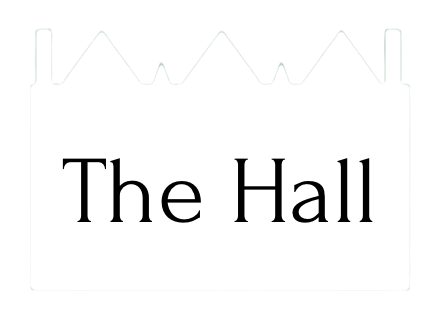THE HALL - THE DUKE OF KINGSTON'S HOUSE
The Duke of Kingston’s House, Bradford on Avon (click to enlarge)
Kingston House - The Hall - around 1841 (click to enlarge)
Elizabeth Chudleigh, Captain Hervey and Evelyn Pierrepont (Duke of Kingston).
The married Maid of Honour, or, the Widow'd Wife and her two Husbands, Unknown artist
line engraving, published 1775
© National Portrait Gallery, London
The ownership of The Hall passed from John Hall to the Pierrepont family in the year 1711. Although John Hall married twice, he left no direct descendants on his death in 1710. His will directed that his legacy be gifted to Rachel Baynton, the fifteen year old daughter of Elizabeth Baynton of nearby Little Chalfield. Whilst Rachel’s legal father was Thomas Baynton, it is believed that John Hall was her actual father. This will featured an unusual condition in that if Rachel were to marry a man with no title, they were both to take the name Hall. If the match was not approved of by Rachel’s trustees (as appointed by John Hall), the benefits would be reduced - but not completely withdrawn.
The wealth bequested to Rachel Baynton was munificent, including both The Hall in Bradford on Avon and Great Chalfield Manor. John Hall’s nephew, William, contested the will; his objection was thrown out. In that same year, 1711, Rachel married William Pierrepont, the Earl of Kingston-upon-Hull and heir to the Duke. Two children were born, Evelyn and Frances, before tragedy struck. William Pierrepont died of smallpox in 1713, scarcely two years after their marriage. He was only twenty-one years of age. Rachel imfamously became mistress to Lord Lumley and bore two illegitimate children by him before her untimely death in 1722 at the age of twenty-seven.
William and Rachel’s son, Evelyn, inherited the great houses in Bradford (The Hall) and at Great Chalfield at the tender age of ten. Following the death of his paternal grandfather in 1726 he became the Duke of Kingston and a very wealthy - and very young - member of the aristocracy. The Hall became known as ‘The Duke’s House’ or ‘Kingston House’ or even, as illustrated here, ‘The Duke of Kingston’s House’. The Duke did not reside in Bradford; he lived at Dean House in West Dean, Wiltshire. The Hall was let out, whilst reserving some rooms for the family. Later, in 1751, The Hall was let to Thomas Rogers, a local clothier.
The Duke was not quick to wed and waited until 1769 before marrying his mistress, Elizabeth Chudleigh. He died only four years later, without discovering that he had made the rather grave error of marrying a woman who was already married to another man. His widow, Elizabeth, was bequeathed use of The Hall for life. However, the twists and turns of fate prevented her from residing here other than very occasionally.
Elizabeth, the notorious Duchess of Kingston, was known for her colourful and adventurous lifestyle and had secretly married Augustus Hervey in 1744. Their marriage was unhappy and they lived apart, and there was an understanding that a secret union did not need to be dissolved. However, Hervey inherited the title of Earl of Bristol in 1775 and hence Elizabeth Chudleigh became the Countess of Bristol - it is thought that she falsely created the registry entries to confirm their secret marriage. This plan backfired badly as the late Duke’s nephew, Evelyn Medows, brought a charge of bigamy against her as a route towards challenging his Uncle’s will. Chudleigh was found guilty in 1776 and fled overseas to avoid further charges.
From 1771 onwards The Hall was let to John Baskerville, another of Bradford’s clothiers. Following the death of the Duchess of Kingston / Countess of Bristol in 1788, The Hall passed to Charles Medows, Viscount Newark and later Earl Manvers. In 1805 the house, the grist mill and the surrounding nine acres were sold to Thomas Divett of London.
This illustration of ‘The Duke of Kingston’s House’ is difficult to accurately date but appears to be from Divett’s time, shortly before the property was sold to Stephen Moulton in 1848. The side terraces have not yet been built, whereas the outbuildings in front of the house are present. These buildings are not shown on the plan on the sale to Divett in 1805, but do appear on the 1841 tithe map. There are no balustrades on the stairway up to the terrace, and the two ‘dummy’ chimneys are missing from the front of the house. There are other differences, but these are the most obvious. Visitors to the gardens at The Hall may, if looking closely, see some clues as to where these outbuildings were. It is likely that most of the stonework was used to build the terrace walls.
The ownership of The Hall by the Duke of Kingston-upon-Hull has left its mark on the town - we have Kingston Farm, Kingston Road, Kingston Square and Kingston Mills (although the Mill itself was demolished in the 1970s). Confusingly, we also have another ‘Kingston House’, just to the south-west of The Hall on Kingston Road (previously ‘Mill Street’ as shown on the plan). This is, of course, just one small part of the history of ‘The Hall’. You can read more here, or in Pamela Slocombe’s book, ‘The Hall’, available from our online shop.

